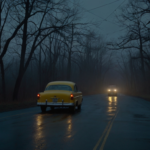Horror movies have always drawn inspiration from the dark recesses of reality. Often, the most terrifying tales on screen are those that echo real-life events, where the line between fiction and fact becomes disturbingly blurred. True crime cases have provided filmmakers with a chilling canvas, turning the horrors of the past into nightmarish cinema. In this article, we’ll explore some of the most terrifying true crime cases that inspired horror movies, delving into the gruesome details and the cinematic portrayals that followed. These stories remind us that sometimes, reality is far scarier than fiction. Here are Terrifying True Crime Cases That Inspired Horror Movies.
1. The Texas Chainsaw Massacre: The Ed Gein Case

One of the most infamous true crime cases to horror movies is the story of Ed Gein, which inspired the 1974 classic, “The Texas Chainsaw Massacre.” Gein, a reclusive man from Plainfield, Wisconsin, was arrested in 1957 for the murder of two women. However, it was what authorities found at his home that truly shocked the world.
Gein had a macabre hobby of exhuming corpses from local cemeteries and using their skin and bones to create household items, clothing, and even masks. His gruesome practices became the basis for the character Leatherface, the chainsaw-wielding antagonist in the movie. “The Texas Chainsaw Massacre” doesn’t replicate Gein’s crimes directly, but it captures the essence of the horror that his actions represented. The film’s portrayal of a family of cannibalistic killers was a heightened reflection of Gein’s twisted reality, making it one of the most terrifying horror movies ever made.
2. Psycho: The Ed Gein Influence Again
Ed Gein’s horrific crimes didn’t just inspire “The Texas Chainsaw Massacre.” His story also served as the foundation for Alfred Hitchcock’s 1960 masterpiece, “Psycho.” The character of Norman Bates, played by Anthony Perkins, was heavily influenced by Gein’s disturbing relationship with his mother.
In “Psycho,” Bates is a lonely motel owner with a split personality. He assumes the identity of his deceased mother, committing murders while dressed in her clothes. Gein’s unhealthy attachment to his mother, combined with his practice of grave-robbing and creating female skin suits, became the blueprint for Bates’ character. “Psycho” remains a landmark in the horror genre, illustrating how true crime cases to horror movies can leave a lasting impact on audiences.
3. The Amityville Horror: The Lutz Family Haunting
In 1974, Ronald DeFeo Jr. murdered his entire family in their home in Amityville, New York. A year later, the Lutz family moved into the same house, only to flee 28 days later, claiming they had been terrorized by paranormal activity. Their experiences became the basis for the 1979 film “The Amityville Horror.”
While the DeFeo murders were undeniably tragic, it was the Lutz family’s alleged encounters with supernatural forces that turned the case into a horror phenomenon. The film portrayed the house as a malevolent entity, amplifying the fear that such evil could be rooted in a true crime case to horror movies. The debate over the authenticity of the Lutz family’s claims continues to this day, but the story’s influence on horror cinema is undeniable.
4. Zodiac: The Unsolved Mystery
The Zodiac Killer is one of America’s most notorious and elusive serial killers, responsible for a series of murders in the late 1960s and early 1970s. Despite numerous investigations and suspects, the killer was never caught, and the case remains unsolved. This real-life mystery inspired David Fincher’s 2007 film “Zodiac,” which meticulously chronicles the investigation.
“Zodiac” is a chilling reminder of how some true crime cases to horror movies remain unresolved, leaving the public with a lingering sense of fear and uncertainty. The film’s portrayal of the killer’s taunting letters and cryptic ciphers captures the terror that gripped the San Francisco Bay Area during the Zodiac’s reign of terror. The fact that the killer was never apprehended adds an extra layer of horror to the story, making it one of the most unsettling true crime adaptations in cinema.
5. The Exorcism of Emily Rose: The Anneliese Michel Terrifying True Crime Cases
“The Exorcism of Emily Rose” (2005) is based on the harrowing case of Anneliese Michel, a young German woman who died in 1976 after undergoing 67 exorcisms. Michel suffered from severe mental illness, including epilepsy and psychosis, but her devoutly religious family believed she was possessed by demons.
The film blends courtroom drama with supernatural horror, exploring the fine line between religious belief and psychological illness. Michel’s death was a tragic outcome of misguided faith and inadequate medical treatment, and the film adaptation serves as a haunting reminder of the dangers of extreme beliefs. As one of the more controversial true crime cases to horror movies, it challenges viewers to question the nature of possession and the responsibilities of those who claim to combat it.
6. The Silence of the Lambs: The Real-Life Inspirations
“The Silence of the Lambs” (1991) introduced audiences to one of cinema’s most iconic villains, Dr. Hannibal Lecter. While Lecter is a fictional character, his creation was influenced by several real-life serial killers, making the film a complex tapestry of true crime cases to horror movies.
One of the primary inspirations for Lecter was Ed Gein, whose gruesome activities we’ve already explored. Additionally, the character of Buffalo Bill, another killer in the film, was inspired by Ted Bundy, who lured women into his car with a fake injury, and Gary Heidnik, who kidnapped and tortured women in his basement. “The Silence of the Lambs” is a masterclass in horror, drawing on the darkest aspects of human nature to create a story that is as psychologically disturbing as it is terrifying.
7. Henry: Portrait of a Serial Killer: The Confessions of Henry Lee Lucas
“Henry: Portrait of a Serial Killer” (1986) is a bleak and unsettling film based on the confessions of Henry Lee Lucas, a drifter who claimed to have murdered hundreds of people across the United States. While many of Lucas’s confessions were later discredited, the film captures the nihilistic and chaotic nature of his crimes.
The movie offers a grim look into the life of a serial killer, eschewing sensationalism for a raw and unflinching portrayal of violence. As one of the most disturbing true crime cases to horror movies, “Henry: Portrait of a Serial Killer” forces viewers to confront the reality of evil, devoid of the glamorization often seen in Hollywood portrayals.
8. Wolf Creek: The Backpacker Murders
“Wolf Creek” (2005) is an Australian horror film inspired by the real-life “Backpacker Murders” committed by Ivan Milat in the 1990s. Milat was convicted of the murder of seven young backpackers who were traveling through the Australian outback.
The film follows a group of backpackers who are captured and tortured by a sadistic killer in the remote outback, echoing the terrifying experiences of Milat’s victims. “Wolf Creek” is a stark reminder of the dangers that can lurk in the most isolated places, and how true crime cases to horror movies can turn the beauty of the natural world into a backdrop for unspeakable horror.
9. The Strangers: The Keddie Cabin Murders
“The Strangers” (2008) is a home invasion horror film that draws inspiration from several true crime cases to horror movies, including the Keddie Cabin Murders of 1981. In this unsolved case, four people were brutally murdered in a remote cabin in California, and the perpetrators were never identified.
The film captures the sheer terror of being targeted by unknown assailants in the supposed safety of one’s own home. The randomness and brutality of the crime in “The Strangers” mirror the real-life fear that unsolved cases like the Keddie Cabin Murders can evoke, making the film a chilling exploration of vulnerability and violence.
10. Annabelle: The Real-Life Haunted Doll
The “Annabelle” series of horror movies, part of the “Conjuring” universe, is based on the real-life story of a supposedly haunted doll. The doll, named Annabelle, was part of the collection of paranormal investigators Ed and Lorraine Warren. The Warrens claimed that the doll was possessed by a malevolent spirit, and it was eventually placed in a locked glass case in their occult museum.
While the true crime cases to horror movies connection here is more about the paranormal than criminal activity, the fear that a seemingly innocent object could be the vessel for evil is a potent concept. The “Annabelle” movies have taken this real-life artifact and woven it into a narrative that has terrified audiences around the world.
11. The Girl Next Door: The Torture and Murder of Sylvia Likens
“The Girl Next Door” (2007) is a harrowing film based on the true story of Sylvia Likens, a teenage girl who was tortured and murdered by her caregiver, Gertrude Baniszewski, and her children in 1965. Sylvia and her sister were left in Baniszewski’s care while their parents traveled for work. Over several months, Sylvia was subjected to horrific abuse, including beatings, burnings, and starvation, before eventually succumbing to her injuries.
The film is a disturbing portrayal of this tragic case, illustrating the horrors that can occur behind closed doors in seemingly ordinary neighborhoods. It remains one of the most gut-wrenching true crime cases to horror movies, showing how cruelty and violence can be hidden in plain sight, making it all the more terrifying.
12. Dahmer: The Life and Crimes of Jeffrey Dahmer
Jeffrey Dahmer, also known as the Milwaukee Cannibal, is one of the most infamous serial killers in American history. His gruesome acts, which included the murder and dismemberment of 17 young men and boys between 1978 and 1991, have inspired several films, including “Dahmer” (2002), starring Jeremy Renner.
“Dahmer” delves into the mind of a man who committed some of the most heinous crimes imaginable, including necrophilia and cannibalism. The film presents a disturbing exploration of Dahmer’s life, from his troubled childhood to his eventual capture. As one of the most shocking true crime cases to horror movies, the story of Jeffrey Dahmer continues to horrify and fascinate, serving as a grim reminder of the darkness that can reside within the human soul.
Conclusion
True crime has always held a grim fascination for the public, and when these real-life horrors are translated into film, they become even more potent. The true crime cases to horror movies explored in this article illustrate how the most terrifying stories are often those rooted in reality. These films serve as a reminder that the evil depicted on screen can sometimes pale in comparison to the atrocities committed in the real world. Whether it’s a serial killer’s gruesome deeds or a haunting that defies explanation, these stories continue to captivate and terrify us, blurring the lines between fact and fiction in the most unsettling ways possible.


















































